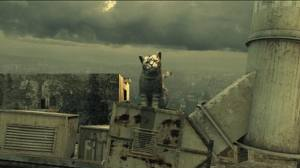
Game: Linger in Shadows
Developer: Plastic
Platform: PC/Mac Review
Drifting through an oil painting of clouds and cream colored skies; a beautiful symphony of harps and violins falls into our ears. We see portraits of members on the developing team: Plastic. Our floating camera lingers at one portrait longer than the others, and a flick of the analog stick shifts a cloud of perfect spheres orbiting each other by changing the direction in which they flow: our first interaction with the game. Then suddenly everything we just saw flies past us in a rewinding fashion and stops as quickly as it started. By means of pictures, we are instructed to rotate our controller in our hands. Flashes and loud crackling noises flow from the screen as we are presented with the game’s flickering title written in white paint: Linger in Shadows.

Poland-based developer Plastic has created art in the demoscene genre since 1997. For the sake of discussion, the genre of demoscene is more of an art style rather than a game genre in the sense that it is made by people who want no more than to create the most beautiful work of programmed art they can and run it on anything from a Play Station 3 to a Ti-84 calculator. In a nutshell, it is pushing the aesthetic limit of any machine out there. That in mind, Plastic created Linger in Shadows to push the PS3’s limit, not in aesthetic beauty, but in its ability to convey art and interaction.
From the start, the intent of this project shines. We are given the option to either “Watch” or “Linger”. Watching allows us the pleasure to observe the entire demo without the want or need to pause and interact with it, but the truer qualities of the game are revealed when we choose to Linger. Returning to where we left off above: after we turn our controller about in our hands, we are flashed forwards again but now taken beyond where we stopped before and into the next scene. Had we been merely watching, we would pass from the credits to the next scene without any interaction in the world at all.

The dimly lit, beige cityscape that is our setting is filled with points of interaction like that; be it pressing the Circle Button repeatedly or madly shaking our controller. In just as many instances, we can pause the game (which moves on its own taking us through the city from behind a black cloud) and use our controller to play around with bits of the world: fluctuate the flow of a stream of black cubes, spin a floating futuristic missile in the air, or rotate a pink flower growing on a patch of floating soil. It is easy to tell by the overall lack of instructions that this game’s focus is exploration. There is no dialogue and no presented plot to keep us from noticing every little detail in the game’s world. It works beautifully as a massive painting in that we cannot help but see everything the artist drew into it.
However, it is inescapable that this is truly a game and cannot just be critiqued on what it presents in focus. It maintains an objective of the key points of the demoscene genre by showcasing the PS3’s graphical capabilities in well rendered and lusciously shaded landscapes along with the potential sound quality through a purposefully composed and stunningly appropriate soundtrack by Wojciech Golczewski- it even takes full advantage of the new Six-Axis controllers’ motion sensing capabilities! Fragments of artwork are hidden throughout the game (finding them will download onto your console the full works of art which are positively stunning) are mixed between easy to get and well hidden, teasing the player with a few easy grabs so that they scour the world for the few elusive pieces thus attaining a reasonably high replay value by coupling the art with Play Station Network Trophies.

The only true issues Linger presents is a relatively high price of three USD for a game that is not much longer than seven minutes in length . In addition to that, the motion controls, which were still in a kind of embryonic stage during Linger’s development, will often become sticky and hard to use at times (and it is fortunate the game is not reliant on them). The game will surely divide its buyers into two factions: those who think the money and minor difficulties are worth the art and beauty, and those who feel their money was not well-spent because they did not have as much fun as they believed three USD would indicate.
As a work of art is profound and complex, it presents many interesting themes of religion and government and what they have become in the modern world. It conveys feelings very well with the music and lighting techniques and makes its interaction important and well-rewarded; it is overall very well made and certainly something to purchase for those who enjoy art and thought. I am certainly proud to have it in my collection of favorites and agree that it was money and time well spent for the sake of art and for the interest of the smaller genres in gaming like demoscene.
by Aidan Moore

Leave a Reply